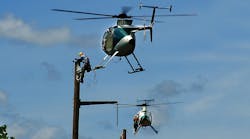Have you ever heard of drone racing? I had not until last fall. I was watching the local news, and a story came on about the first Drone Summit that was being held at Spaceport America in southern New Mexico. The reporter offered the obligatory commentary about the Drone Summit, emphasizing the activities taking place such as workshops, classes, demonstrations and vendor exhibits, but then he jumped to the main event — drone racing.
When it comes to aeronautical technologies, New Mexico boasts several of these “first” such distinctions, including flying saucers, rocketry and the first beyond-visual-line-of-sight (BVLOS) drone flight sanctioned by the Federal Aviation Administration (FAA) in the continental U.S. in 2015. Although I was not surprised to see this news story, I was surprised to see such a positive drone story. The reporter was totally excited about drone racing.
It’s not breaking news that drones are one of the hottest tech trends today. But drones have a public-relations image problem that is impacting their acceptance and ability to evolve into commercial and civil applications. The public associates drones with weapons of war, spies in the sky and crazy hobbyists flying their tech toys in places where they don’t belong. Drones need an image makeover, and something like drone racing could be just the ticket.
Disruptive Regulations
The FAA’s list of regulations for drones is extensive and includes limitations such as the pilot must be able to see the drone flying (called visual line of sight [VLOS]). Drones are not allowed to fly above 400 ft or more than 100 mph, and they can only fly during daylight hours. The list goes on.
These restrictions are reminiscent of the red flag laws enacted in the early days of the automobile. In the U.K., self-propelled vehicles had to have a pedestrian walking ahead of the vehicle waving a red flag or carrying a lantern to warn bystanders of the vehicle’s approach. In the U.S., one state proposed that if a driver of a horseless carriage encountered livestock, the driver had to stop and disassemble the automobile, and then hide the parts until the livestock was gone. There are several other strange laws, but you get the idea.
It’s not that regulations aren’t needed, they are, but we need regulatory agencies to respond faster to the developing drone technology, especially in the commercial marketplace. Drone racing may provide just the push needed.
Getting back to my initial introduction to drone racing at Spaceport America, the drones flew a complicated course at extremely high rates of speed estimated around 100 mph. What was incredible was the way the pilots controlled their amazing flying machines. No one was walking the sidelines with their heads raised to the sky watching their aircraft. They were all sitting in the shade and wearing virtual-reality (VR)-type headsets, which actually provide an augmented-reality (AR) experience, enabled via antennas protruding out from the side of the headset. The goggles pick up live video feeds from a camera mounted on the drone, which is controlled by joysticks. These AR flying goggles give the pilot an almost 3-D view from a digital cockpit of the course the speeding drone is navigating.
Proving on the Racetrack
The streaming video is fascinating, but even more so is the technology on display. This level of flying is not possible with a traditional VLOS approach, because the technology is too dated for today’s drone racing scene. Instead, the pilots are using the more sophisticated AR flying goggles to implement BVLOS technology. It gives them real-time drone’s-eye-view video received directly from the onboard drone cam. AR BVLOS technology allows competitors to fly their drones full throttle through a complex obstacle-filled course, relying solely on streaming video for the split-second course corrections necessary to guide their drones.
Automobile racing proved concepts such as disc brakes, seat belts, fuel injection and many other advancements that we take for granted today. Now drone racing has shown that AR BVLOS technology can be used in this demanding racing environment and performs extremely well. We can make the case that if drone racing is safely accomplished using AR BVLOS, then there is no reason why licensed professional commercial drone pilots should not be permitted. BVLOS is needed to allow commercial drone flights to realize their full potential. These advances would enable us to map transmission corridors, survey vegetation along a transmission line right-of-way, or perform inspections of towers and other facilities in a safe and more cost-effective manner.
Drone racing may seem a little farfetched, but it is proving this cyber-physical technology is fully practical while improving the drone’s public image. ESPN has started giving it coverage recently since major races are taking place worldwide. It doesn’t hurt that prize money is in the millions of dollars, either. Racing is proving to be a positive influence on how we think about drones.


